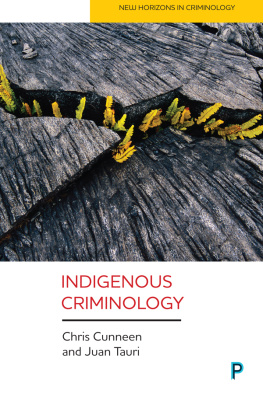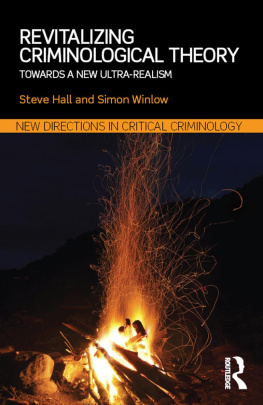
Closing the Integration Gap in Criminology
Closing the Integration Gap in Criminology:The Case for Criminal Thinking offers a multi-stage model of theory integration that organizes verified risk factors around the construct of criminal thinking to provide an exemplar working paradigm for criminology. In the model, once relevant risk factors have been identified, they are organized into triadsthree-variable networks of antecedent, mediating, or moderating effectsand then those triads are combined into clusters of thematically related constructs.
While the debate continues to rage over how to handle the burgeoning number of theories in criminology, little significant progress has been made in reducing the number of such theories. This book argues that theoretical integration is vital to the continued viability of criminological theory and to the growth and development of criminology as a scientific discipline. It posits that criminal thinking may be suitable as a core variable in constructing a useful integrated theory for criminology, and maps out a plan for scholars to organize information for further study.
The innovative theoretical approach in this book is an essential reading for students, academics, and researchers in both criminology and forensic psychology concerned with the reduction in crime via scientific inquiry.
Glenn D. Walters is Professor of Criminal Justice at Kutztown University in Pennsylvania. As a forensic psychologist, he worked for three decades in the federal government as a clinical psychologist and drug program coordinator for military and federal prison inmates. He has published widely in criminology, including on addiction. He has developed the Psychological Inventory of Criminal Thinking Styles (PICTS), one of the most widely used measures of criminal thinking. He argues that criminality is best understood and prevented by examining how it develops within the context of a persons life and has critiqued genetic studies via meta-analytic research.
Routledge Advances in Criminology
The Myth of Moral Panics
Sex, Snuff, and Satan
Bill Thompson and Andy Williams
Drugs and Popular Culture in the Age of New Media
Paul Manning
Criminal Justice in International Society
Edited by Willem de Lint, Marinella Marmo, and Nerida
American Smuggling as White Collar Crime
Lawrence Karson
Young Men and Domestic Abuse
David Gadd, Claire L. Fox, Mary-Louise Corr, Steph Alger and Ian Butler
Frank Tannenbaum:The Making of a Convict Criminologist
Matthew G.Yeager
Reinforcement Sensitivity Theory
A Metatheory for Biosocial Criminology
Anthony Walsh
Mafia Violence
Political, Symbolic, and Economic Forms of Violence in Camorra Clans
Edited by Monica Massari and Vittorio Martone
Closing the Integration Gap in Criminology
The Case for Criminal Thinking
Glenn D.Walters
For more information about this series, please visit: www.routledge.com/Routledge-Advances-in-Criminology/book-series/RAC
Closing the Integration Gap in Criminology
The Case for Criminal Thinking
Glenn D. Walters
First published 2020
by Routledge
52 Vanderbilt Avenue, New York, NY 10017
and by Routledge
2 Park Square, Milton Park,Abingdon, Oxon, OX14 4RN
Routledge is an imprint of the Taylor & Francis Group, an informa business
2020 Taylor & Francis
The right of Glenn D. Walters to be identified as author of this work has been asserted by him in accordance with sections 77 and 78 of the Copyright, Designs and Patents Act 1988.
All rights reserved. No part of this book may be reprinted or reproduced or utilised in any form or by any electronic, mechanical, or other means, now known or hereafter invented, including photocopying and recording, or in any information storage or retrieval system, without permission in writing from the publishers.
Trademark notice: Product or corporate names may be trademarks or registered trademarks, and are used only for identification and explanation without intent to infringe.
Library of Congress Cataloging-in-Publication Data
A catalog record for this title has been requested
ISBN: 978-0-367-34770-3 (hbk)
ISBN: 978-0-429-32887-9 (ebk)
Contents
PART I
Integration in Criminology
PART II
Integrating with Criminal Thinking
In the two-and-one-half centuries since Cesare Beccaria (1764) published his groundbreaking treatise, On Crime and Punishment , the field of criminology has been without a guiding theory or paradigm, and as such, it has never known normal science (Kuhn, 2012). This is also true of many other areas of social scientific inquiry, although there is a fundamental difference between how criminology and other social sciences, like psychology and sociology, currently approach the issue of theoretical integration. Whereas psychology and sociology have their share of mini-theories designed to explain specific phenomena, they have sought to limit the number of grand theories designed to explain the field itself. Criminology, by contrast, continues to add new theories each year. This has given the field a fragmented appearance (Ericson & Carriere, 1994) and made it difficult for criminologists to communicate with each other, absent a shared vocabulary or common set of assumptions, principles, and tenets. The purpose of the present book is to address this problem as an initial step in rectifying it.
I would like to start by acknowledging that there are many good ideas contained in the large number of theories being bandied about in criminology. I cant imagine trying to understand crime without the aid of such micro-level constructs as negative peer associations (Sutherland, 1947), weak parental control (Gottfredson & Hirschi, 1990), listless parental support (Hirschi, 1969), and individual-level strain (Agnew, 1992). Nor do I think it would be possible to understand crime without taking such macro-level considerations as secondary deviance (Lemert, 1967), decreased legitimate opportunities for success (Merton, 1957), and class conflict (Reiman, 1998) into account. Still, none of these theories fully explains crime. Even Gottfredson and Hirschis (1990) general theory of crime is not as general or as comprehensive as the authors make it out to be. This is what happens when you use a small number of concepts to explain a phenomenon as complex as crime. The three variables that drive Gottfredson and Hirschis theorylow self-control, opportunity, and choicewhile important, do not constitute a comprehensive theory of crime. What about moral values, setting effects, developmental pathways, and temperament?
Theoretical integration is by no means new to the field of criminology. From Thornberry (1987) to Sampson and Laub (1993) and from Moffitt (1993) to Wikstrm (2004), constructs from different theories have been organized into single theories through a process of integration and elaboration. Attempts have even been made to merge entire theories (Elliott, Ageton, & Canter, 1979; Elliott, Huizinga, & Ageton, 1985), although this approach has been criticized by those who believe the best way to reduce the number of theories in a field is by having them compete with one another (Hirschi, 1979). Comparing theories and removing those that are falsified have proven unsatisfactory, because most theories of crime hold some degree of truth and cannot be completely falsified (Elliott, 1985). Combining entire theories, on the other hand, has been no more effective than falsification; and such efforts have produced theories that are disjointed, contradictory, and beset by logical inconsistencies because the fundamental assumptions of criminological theories are often incompatible (Hirschi, 1989).






